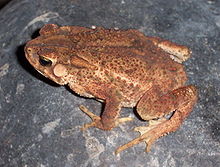
Bufo is a genus of true toads in the amphibian family Bufonidae. As traditionally defined, it was a wastebasket genus containing a large number of toads from much of the world but following taxonomic reviews most of these have been moved to other genera, leaving only seventeen extant species from Europe, northern Africa and Asia in this genus, including the well-known common toad. Some of the genera that contain species formerly placed in Bufo are Anaxyrus, Bufotes, Duttaphrynus, Epidalea and Rhinella.
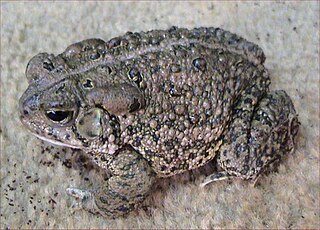
Woodhouse's toad is a medium-sized true toad native to the United States and Mexico. There are three recognized subspecies. A. woodhousii tends to hybridize with Anaxyrus americanus where their ranges overlap.

Duttaphrynus, named after Sushil Kumar Dutta, is a genus of true toads endemic to southwestern and southern China, Taiwan and throughout southern Asia from northern Pakistan and Nepal through India and Bangladesh to Sri Lanka, Andaman Island, Sumatra, Java, Borneo and Bali.
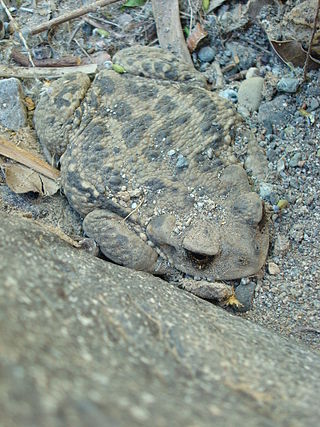
Rhinella arunco is a species of toad in the family Bufonidae that is endemic to Chile. Its natural habitats are subtropical or tropical dry shrubland, rivers, intermittent rivers, freshwater marshes, intermittent freshwater marshes, water storage areas, ponds, aquaculture ponds, open excavations, and irrigated land. It is threatened by habitat loss.
Rhinella bergi is a species of toad in the family Bufonidae that is found in Argentina, Brazil, and Paraguay. Its natural habitats are dry savanna, moist savanna, subtropical or tropical seasonally wet or flooded lowland grassland, freshwater marshes, intermittent freshwater marshes, arable land, pastureland, and ponds. It is threatened by habitat loss.
Rhinella gallardoi is a species of toad in the family Bufonidae that is endemic to Argentina. Its natural habitat is temperate forests. It is threatened by habitat loss.
Rhinella gnustae is a species of toad in the family Bufonidae that is endemic to Argentina. Its natural habitat is rivers. It is threatened by habitat loss.
Rhinella henseli is a species of toad in the family Bufonidae that is endemic to Brazil. Its natural habitats are subtropical or tropical moist lowland forests, rivers, and intermittent freshwater marshes. It is threatened by habitat loss.
Rhinella inca is a species of toad in the family Bufonidae that is endemic to Peru. Its natural habitats are subtropical or tropical moist montane forests, rivers, and canals and ditches.

Ingerophrynus quadriporcatus is a species of toad in the family Bufonidae. Its common names are long-glanded toad, four-ridged toad and greater Malacca toad. It is found in Peninsular Malaysia, Singapore, Borneo, Sumatra, and the Natuna Islands. Its natural habitats are swamp forests, but it has also been found on rubber plantations. It breeds in standing water.
Rhinella rumbolli is a species of toad in the family Bufonidae that is found in Argentina and possibly Bolivia. Its natural habitats are temperate forests and rivers. It is threatened by habitat loss.
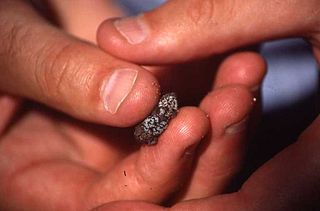
Mertensophryne is a genus of true toads. They are found in eastern and southern Democratic Republic of Congo to Kenya, Tanzania, Malawi, southeastern Zimbabwe, and adjacent Mozambique. Their common names include snouted frogs, Chirinda forest toads, and forest toads. The genus is named for Robert Mertens, German zoologist and herpetologist.

Sclerophrys is a genus of "true toads", family Bufonidae, native to Africa and the southern Arabian Peninsula. Originally, all of these species were classified in the genus Bufo. The genus, originally named Amietophrynus, was split due to large enough taxonomic divergence. Ohler and Dubois showed in 2016 that Sclerophrys capensis Tschudi, 1838 is the same species as Bufo regularis rangeri Hewitt, 1935, the type species of Amietophrynus. Because the former name is older, the implication is that Amietophrynus is a junior synonym of Sclerophrys.
Humerana miopus, also known as the Khao Wang frog or three-striped frog, is a frog that was identified in 1918. This species is known from southern Thailand and Peninsular Malaysia, and it is locally common.
Jonathan Atwood Campbell is an American herpetologist. He is currently professor of biology at University of Texas at Arlington. He was a distinguished professor and chair of the Department of Biology, University of Texas at Arlington, Arlington, Texas.

Feihyla is a genus of frogs in the family Rhacophoridae, subfamily Rhacophorinae. They are found in southern China and Vietnam, and likely also in Laos. Its phylogenetic position is not yet fully resolved, but it is probably the sister taxon to Taruga, Polypedates, and Rhacophorus. Feihyla was originally erected to resolve polyphyly of Chirixalus by absorbing "Chirixalus palpebralis".

Poyntonophrynus, also known as pygmy toads, are a genus consisting of ten true toad species native to Sub-Saharan Africa. Originally, all Poyntonophrynus species were included in the genus Bufo. The genus was split due to large enough taxonomic divergence as evidenced by molecular markers. The genus is named in honour of John C. Poynton, South African herpetologist, with phrynus being Greek for toad.
Nannophryne is a small genus of true toads, family Bufonidae, from South America. They are found in central Andean Peru south to southern Chile and adjacent Argentina.
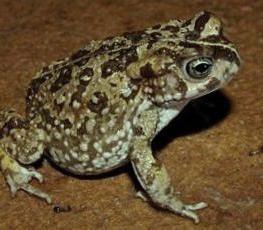
Vandijkophrynus, also known as Van Dijk's toads, are a small genus of true toads, family Bufonidae. They are native to Southern Africa. The name commemorates Eddie Van Dijk, a South African herpetologist.
Ronald Archie Nussbaum is an American herpetologist. He works with evolutionary biology and ecology of amphibians and reptiles, including systematics of caecilians and salamanders. He is a professor emeritus at the University of Michigan.
